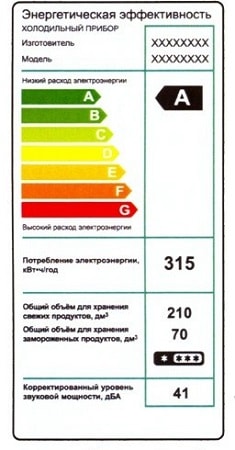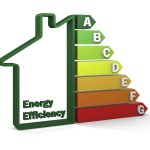How much electricity does a refrigerator consume? This question is especially common towards the end of the next month, when receiving electricity bills from utilities. The refrigerator is a fairly powerful unit. It is considered the main consumer of electricity for two seemingly rational reasons:
- In terms of its dimensions, it is the largest electrical appliance in almost any home;
- Unlike, for example, a TV, microwave oven and other electrical and household appliances, it is connected to the mains continuously.
In fact, these two factors today do not so much affect the level of electricity consumption. And the refrigerator does not always consume the greatest number of watts per hour or even per month. Everything is a little more complicated than it might seem.
First of all, the amount of energy consumed does not matter per hour, month or year determines the so-called class of energy consumption. Let's get acquainted with it in more detail.
![]() See also - Simple rules for saving electricity at home
See also - Simple rules for saving electricity at home
Energy class of refrigerators
The energy consumption classes of refrigerators have long been established by world standards, which are valid and the same for all countries of the world. They are designated by Latin capital letters each, which means a certain percentage of power from the standard level.
Advice:
Read also: Which refrigerator is better to choose in 2019: rating and expert reviews
- "A ++" top class, installed on household appliances with maximum energy savings, energy consumption is up to 30%;
- "A +" class: power "30-42%";
- "A" class: power "42-55%";
- "B" class: power "55-75%";
- "C" class: power "75-90%";
- "D" class: power "90-100%";
- "E" class: power "100-110%"
- "F" class, the highest energy consumption can be found only on outdated equipment, the capacity is 110-125% of the standard.

You can find out what class of power consumption this or that refrigerator belongs to, and how much energy it consumes per month from the instructions or description. Sometimes the marking is also applied to the unit itself in the form of a letter, or the number of kilowatts consumed by it is immediately indicated. The absence of such markings usually indicates a high energy consumption. When buying a new refrigerator in a store, the easiest way to find out the amount of watts consumed per month is to ask the seller.
The required energy consumption for the operation of almost any household appliance is determined mainly by the energy class to which it belongs. Therefore, if there is an old and noisy unit at home, then you should not be surprised at large electricity bills, since most likely it belongs to one of the last classes and consumes a huge amount of kilowatts every hour.
Important:
It is important to understand that it is impossible to save money on the operation of the refrigerator, because it usually stores products that become unusable per day, and sometimes an hour of stay in conditions with inappropriate temperatures is enough.The only way out is to buy a new refrigerator that does not require a lot of watts, which, however, will pay off pretty quickly.
![]() See also - Why does a refrigerator need a voltage regulator?
See also - Why does a refrigerator need a voltage regulator?
How much electricity does the refrigerator consume in kW per year?
Determining how much the refrigerator consumes electricity per hour, per day or month is quite simple, just look at its technical characteristics, which should be indicated in the operating instructions. The level of electricity consumption of modern refrigerators on the domestic market ranges from 220 kW to 460 kW per year. Let's say that your refrigerator consumes 460 kW per year, respectively, to find out how much the refrigerator consumes kW per day, you need to divide the indicated figures by 365 days and get the initial data. You will get -1.26 kW per day, about 38 kW or 50 W per hour (0.05 kW per hour) per month.
Advice:
Read also: How much power does the washing machine consume in kW
However, these figures are very averaged. Since, in fact, there are also indirect factors that can significantly affect the amount of kilowatts consumed by the refrigerator per hour.
Indirect factors affecting the level of energy consumption
- Indoor air temperature - everything is simple here, the higher the temperature of the air surrounding the refrigerator, the more it consumes watts per hour to maintain the optimal temperature inside;
- The quality of the sealing materials and their design, as well as the material from which the refrigerator is made and even its color can affect the amount of kW required every month;
- How often a refrigerator is used, or more simply, how often doors are opened and closed, can also affect energy consumption. If the doors are opened every hour, then the unit will consume an increased amount of kW to restore the optimum temperature;
- Various additional functions such as ice dispensing or lighting of individual elements of the unit increase the number of watts required by the refrigerator. Usually these features remain unclaimed, but you still have to pay for them every month.
Finally, it should only be noted that household appliances that have the lowest energy consumption in kW per day, in addition to the benefits for the wallet of their owner, also have a positive effect on the environmental situation on the planet.
See also:


The level of electricity consumption of modern refrigerators on the domestic market ranges from 220 kW to 460 kW per year.
It may be more correct to write:
220-460 kW * hour per year of operation.